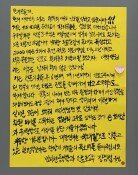China-bashing spreads in and outside U.S.
China-bashing spreads in and outside U.S.
Posted December. 16, 2019 07:48,
Updated December. 16, 2019 07:48
A lawyer working at a mid-sized law firm in Washington is seeing a noticeable increase in Chinese clients recently. Chinese scientists in the U.S. are under surveillance by the U.S. government and experiencing restrictions with unclear reasons. “It seems like intelligence agents are assigned to Chinese scientists one-on-one for close surveillance,” said the lawyer said. “The bad relations between the U.S. and China are bringing more clients for me.”
I was wondering if indeed researchers in the private sector are surveilled to such a degree but the look on the lawyer’s face seemed quite serious. As seen in Huawei’s case, the Trump administration’s activities to check China’s technology hegemony are expanding in all directions. It is also undeniable that China-bashing is a clear direction in Washington’s foreign security.
It was also unusual for the North Atlantic Treaty Organization (NATO), which marked its 70th anniversary this year, to target China in its summit statement in early December. It was based on the grounds that China’s attack on Africa, cyber activities, and growing military power pose new challenges to Europe, but it was rather random for the NATO to target the country on the opposite side of the Earth. The U.S., a NATO member with big influence, seems to be behind such targeting as if the U.S.’ aggressive strategy against China is being exported.
In addition, more and more think tanks are reinforcing their research on China. The Center for Strategic and International Studies newly created four teams to study China by different fields. In December alone, there were a series of seminars on China, such as “China’s rise and global order,” “human rights issues in China and the U.S.’ responses,” and “political, religious, and human rights issues in China.” Yet, it is hard to find Chinese participants at seminar venues. Rather, they are filled with local researchers and media persons, as well as foreign reporters from Hong Kong, Taiwan, South Korea, etc. It seems like the Chinese find it uncomfortable to show up to such venues due to strong China-bashing sentiment.
The tension between the U.S. and China seems to have been eased to a degree as the two reached a phase one trade agreement. However, phase two negotiations involving much trickier stuff, such as intellectual property rights, will be much tougher. The bilateral relation may be in truce now but there is no sign that it will improve going forward.
It has been a long time since China has become a constant, rather than a variable, in the U.S.’ foreign security policy. Opposition from Beijing is growing amid such conflicts and the circumstances in Northeast Asia are becoming more unstable. Considering the issue surrounding North Korea, which made threats about a “new path” from next year, diplomatic functions to be solved between the two powerhouses will become even more complicated. More analysis and research, not only on China but also on the U.S.’ policy and strategy towards China, will be needed in the near future.
lightee@donga.com
Headline News
- Med professors announce intention to leave hospitals starting Thursday
- Bridge honoring Sgt. Moon Jae-sik unveiled in Pennsylvania
- Chief of Staff Chung tells presidential secretaries to stay away from politics
- US FTC bans noncompete agreements
- N. Korea launches cyberattacks on S. Korea's defense companies







